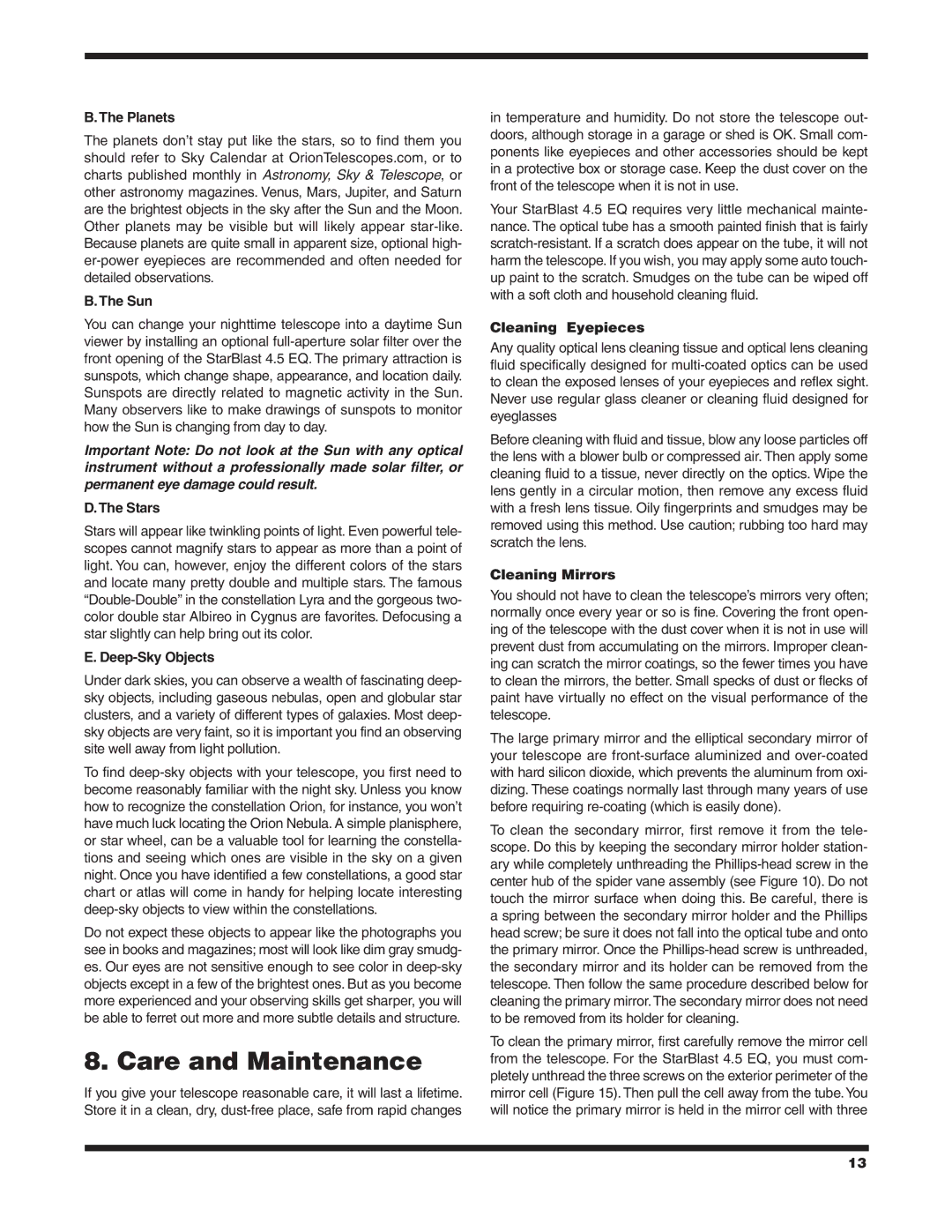
B.The Planets
The planets don’t stay put like the stars, so to find them you should refer to Sky Calendar at OrionTelescopes.com, or to charts published monthly in Astronomy, Sky & Telescope, or other astronomy magazines. Venus, Mars, Jupiter, and Saturn are the brightest objects in the sky after the Sun and the Moon. Other planets may be visible but will likely appear
B.The Sun
You can change your nighttime telescope into a daytime Sun viewer by installing an optional
Important Note: Do not look at the Sun with any optical instrument without a professionally made solar filter, or permanent eye damage could result.
D.The Stars
Stars will appear like twinkling points of light. Even powerful tele- scopes cannot magnify stars to appear as more than a point of light. You can, however, enjoy the different colors of the stars and locate many pretty double and multiple stars. The famous
E. Deep-Sky Objects
Under dark skies, you can observe a wealth of fascinating deep- sky objects, including gaseous nebulas, open and globular star clusters, and a variety of different types of galaxies. Most deep- sky objects are very faint, so it is important you find an observing site well away from light pollution.
To find
Do not expect these objects to appear like the photographs you see in books and magazines; most will look like dim gray smudg- es. Our eyes are not sensitive enough to see color in
8. Care and Maintenance
If you give your telescope reasonable care, it will last a lifetime. Store it in a clean, dry,
in temperature and humidity. Do not store the telescope out- doors, although storage in a garage or shed is OK. Small com- ponents like eyepieces and other accessories should be kept in a protective box or storage case. Keep the dust cover on the front of the telescope when it is not in use.
Your StarBlast 4.5 EQ requires very little mechanical mainte- nance. The optical tube has a smooth painted finish that is fairly
Cleaning Eyepieces
Any quality optical lens cleaning tissue and optical lens cleaning fluid specifically designed for
Before cleaning with fluid and tissue, blow any loose particles off the lens with a blower bulb or compressed air. Then apply some cleaning fluid to a tissue, never directly on the optics. Wipe the lens gently in a circular motion, then remove any excess fluid with a fresh lens tissue. Oily fingerprints and smudges may be removed using this method. Use caution; rubbing too hard may scratch the lens.
Cleaning Mirrors
You should not have to clean the telescope’s mirrors very often; normally once every year or so is fine. Covering the front open- ing of the telescope with the dust cover when it is not in use will prevent dust from accumulating on the mirrors. Improper clean- ing can scratch the mirror coatings, so the fewer times you have to clean the mirrors, the better. Small specks of dust or flecks of paint have virtually no effect on the visual performance of the telescope.
The large primary mirror and the elliptical secondary mirror of your telescope are
To clean the secondary mirror, first remove it from the tele- scope. Do this by keeping the secondary mirror holder station- ary while completely unthreading the
To clean the primary mirror, first carefully remove the mirror cell from the telescope. For the StarBlast 4.5 EQ, you must com- pletely unthread the three screws on the exterior perimeter of the mirror cell (Figure 15). Then pull the cell away from the tube.You will notice the primary mirror is held in the mirror cell with three
13
